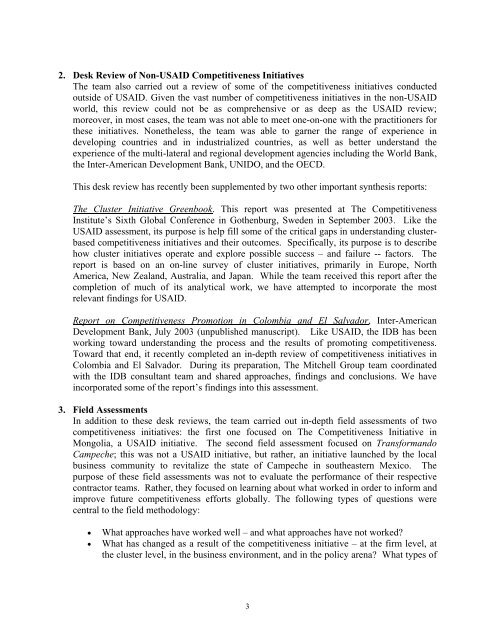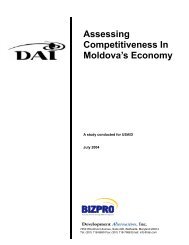Promoting Competitiveness in Practice - Economic Growth - usaid
Promoting Competitiveness in Practice - Economic Growth - usaid
Promoting Competitiveness in Practice - Economic Growth - usaid
You also want an ePaper? Increase the reach of your titles
YUMPU automatically turns print PDFs into web optimized ePapers that Google loves.
2. Desk Review of Non-USAID <strong>Competitiveness</strong> Initiatives<br />
The team also carried out a review of some of the competitiveness <strong>in</strong>itiatives conducted<br />
outside of USAID. Given the vast number of competitiveness <strong>in</strong>itiatives <strong>in</strong> the non-USAID<br />
world, this review could not be as comprehensive or as deep as the USAID review;<br />
moreover, <strong>in</strong> most cases, the team was not able to meet one-on-one with the practitioners for<br />
these <strong>in</strong>itiatives. Nonetheless, the team was able to garner the range of experience <strong>in</strong><br />
develop<strong>in</strong>g countries and <strong>in</strong> <strong>in</strong>dustrialized countries, as well as better understand the<br />
experience of the multi-lateral and regional development agencies <strong>in</strong>clud<strong>in</strong>g the World Bank,<br />
the Inter-American Development Bank, UNIDO, and the OECD.<br />
This desk review has recently been supplemented by two other important synthesis reports:<br />
The Cluster Initiative Greenbook. This report was presented at The <strong>Competitiveness</strong><br />
Institute’s Sixth Global Conference <strong>in</strong> Gothenburg, Sweden <strong>in</strong> September 2003. Like the<br />
USAID assessment, its purpose is help fill some of the critical gaps <strong>in</strong> understand<strong>in</strong>g clusterbased<br />
competitiveness <strong>in</strong>itiatives and their outcomes. Specifically, its purpose is to describe<br />
how cluster <strong>in</strong>itiatives operate and explore possible success – and failure -- factors. The<br />
report is based on an on-l<strong>in</strong>e survey of cluster <strong>in</strong>itiatives, primarily <strong>in</strong> Europe, North<br />
America, New Zealand, Australia, and Japan. While the team received this report after the<br />
completion of much of its analytical work, we have attempted to <strong>in</strong>corporate the most<br />
relevant f<strong>in</strong>d<strong>in</strong>gs for USAID.<br />
Report on <strong>Competitiveness</strong> Promotion <strong>in</strong> Colombia and El Salvador, Inter-American<br />
Development Bank, July 2003 (unpublished manuscript). Like USAID, the IDB has been<br />
work<strong>in</strong>g toward understand<strong>in</strong>g the process and the results of promot<strong>in</strong>g competitiveness.<br />
Toward that end, it recently completed an <strong>in</strong>-depth review of competitiveness <strong>in</strong>itiatives <strong>in</strong><br />
Colombia and El Salvador. Dur<strong>in</strong>g its preparation, The Mitchell Group team coord<strong>in</strong>ated<br />
with the IDB consultant team and shared approaches, f<strong>in</strong>d<strong>in</strong>gs and conclusions. We have<br />
<strong>in</strong>corporated some of the report’s f<strong>in</strong>d<strong>in</strong>gs <strong>in</strong>to this assessment.<br />
3. Field Assessments<br />
In addition to these desk reviews, the team carried out <strong>in</strong>-depth field assessments of two<br />
competitiveness <strong>in</strong>itiatives: the first one focused on The <strong>Competitiveness</strong> Initiative <strong>in</strong><br />
Mongolia, a USAID <strong>in</strong>itiative. The second field assessment focused on Transformando<br />
Campeche; this was not a USAID <strong>in</strong>itiative, but rather, an <strong>in</strong>itiative launched by the local<br />
bus<strong>in</strong>ess community to revitalize the state of Campeche <strong>in</strong> southeastern Mexico. The<br />
purpose of these field assessments was not to evaluate the performance of their respective<br />
contractor teams. Rather, they focused on learn<strong>in</strong>g about what worked <strong>in</strong> order to <strong>in</strong>form and<br />
improve future competitiveness efforts globally. The follow<strong>in</strong>g types of questions were<br />
central to the field methodology:<br />
• What approaches have worked well – and what approaches have not worked?<br />
• What has changed as a result of the competitiveness <strong>in</strong>itiative – at the firm level, at<br />
the cluster level, <strong>in</strong> the bus<strong>in</strong>ess environment, and <strong>in</strong> the policy arena? What types of<br />
3
















